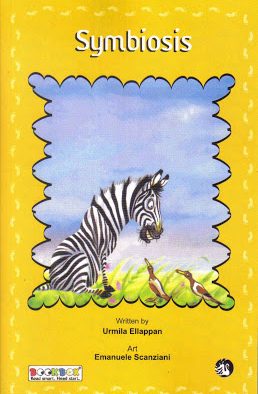A British and South African Perspective on Our Books – Part 3

 Our hardworking interns Naomi and Amani have become master reviewers during their internship with us. They have actually managed to review 170 of our books. Yes, yes… you read that right.. 170 titles! Phew!! So, we decided to share their perspectives (Naomi’s British perspective and Amani’s South African perspective) on our books.
Our hardworking interns Naomi and Amani have become master reviewers during their internship with us. They have actually managed to review 170 of our books. Yes, yes… you read that right.. 170 titles! Phew!! So, we decided to share their perspectives (Naomi’s British perspective and Amani’s South African perspective) on our books.Naomi says…
“Symbiosis” is interesting as it is fundamentally just an explanation of what “Symbiosis” is : “Animals helping each other.” However the book puts this explanation into context, creating a story around it so that it is not clear that this is what the book’s purpose is until the final page. The reason that this is so effective lies in the title, naming the book “Symbiosis”, a word that most children and adults will not be familiar with, immediately creates interest and keeps the reader engaged, as they will be keen to know why a book about
“Zippy the Zebra” has such an unusual title.The story itself is very simple- Zippy is irritated by the itchy fleas on his back and repeatedly tries, in vain, to get them off. He has just about given up when he notices two birds, Pick and Peck, and they happily volunteer to eat up what they consider to be “a splendid meal.” This is an alternate way to communicate to children the common phrase “one man’s meat is another man’s poison”, i.e. just because you like/dislike something doesn’t mean that everyone else feels the same.
Although this story is set in Africa this is a message that rings true all over the world, and is a relevant message to all children. However what children may enjoy most about this book is the feeling that they are learning a little bit about Africa. Referring to “a baobab tree” and grassland as “savannah”, although perhaps unfamiliar words with children in India and the UK and elsewhere, adds to the authenticity of the book. However what I believe is the highlight of the book and what contributes most towards the book’s “African feel”, are the illustrations. These are done using watercolours and are of blurry backdrops which are brightly coloured but not detailed, teamed with clear, detailed images of Zippy the Zebra, and later the birds too. These illustrations add a lot to the overall enjoyment of the book and are what may first attract children to “Symbiosis.” I believe that just as all these elements make the book fun and appealing to children in India, they will be equally attractive to children in Britain, who will also appreciate the subtle moral message, learning about what “Symbiosis” is, the beautiful illustrations and most of all the general feeling of reading about Africa.
Amani’s view of the book was as follows…
A simplistic tale about how a zebra finds friends and how they help him with his pain. On an educational level, it shows the process of symbiosis. It is a well planed title because it’s a word that is clearly defined by the interpretations of the story. Though it may seem apparent to viewers as being tough for younger age groups, it is clearly and creatively shown within the context of the story.
The story is very coherent to South Africans as there are many animals, including Zebras, birds and fleas, mentioned in the story. The book adds a more African approach to illustrations, images and figures used. The story though simple conveys its message and shows the protagonist Zebra anguishing with pain and being relieved from it by a simple matter of finding friends. Thus, making the Zebra more lovable to the reader.
The language is simple yet entertaining, emphasizing on words that describe pain such as “ He even tried thumping all four legs at once!” Overall, it is very simple yet allows the interpretation of the story to fit well with the process of symbiosis. Due to its simplistic manner there where no grammatical errors.
The characters have an almost animated or “cartoony” look to them, which show their playfulness to the younger children.
Within a cultural context, a lot of images and relations contribute to the African feel. Words such as “African Savannah” give it that African ambience. A great book that holds good educational meaning.
*Symbiosis is a book published by Orient Longman. Pratham Books and Orient Longman are joint publishers for the language issues of this book.
Read Amani and Naomi’s first review and second review of some of our other books. If you have read the book and wish to share your review, please email us at web(at)prathambooks(dot)org or leave a message in the comments.






